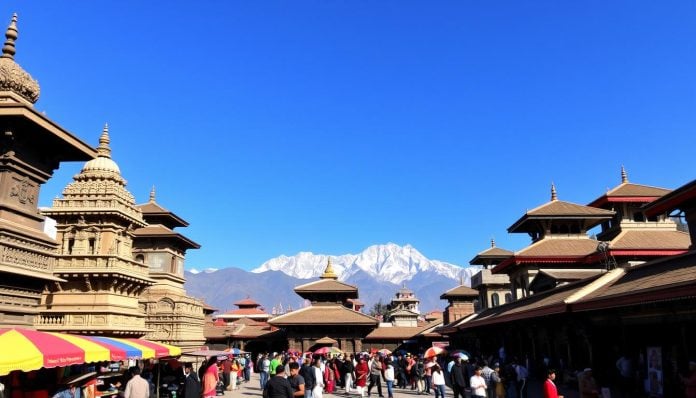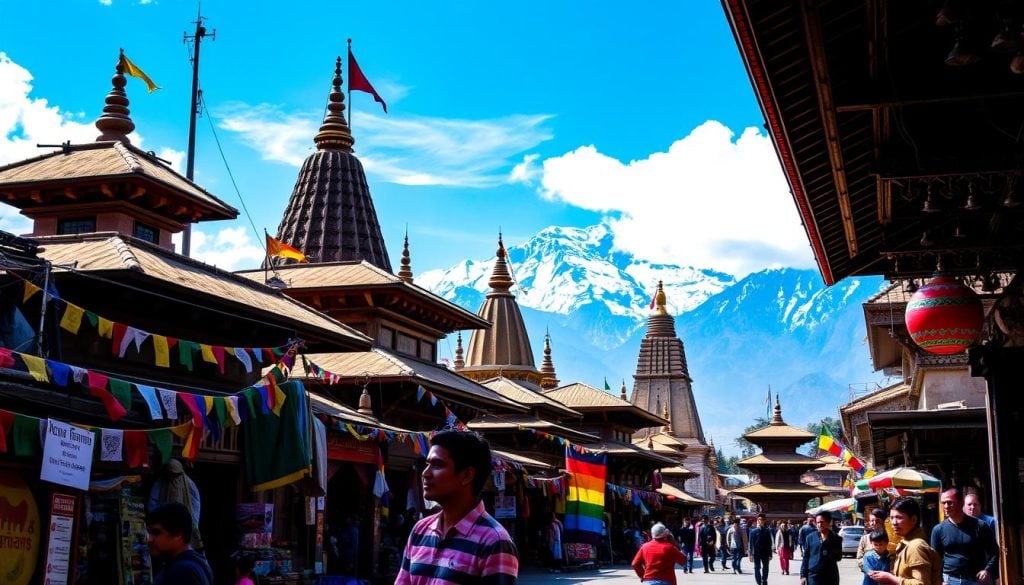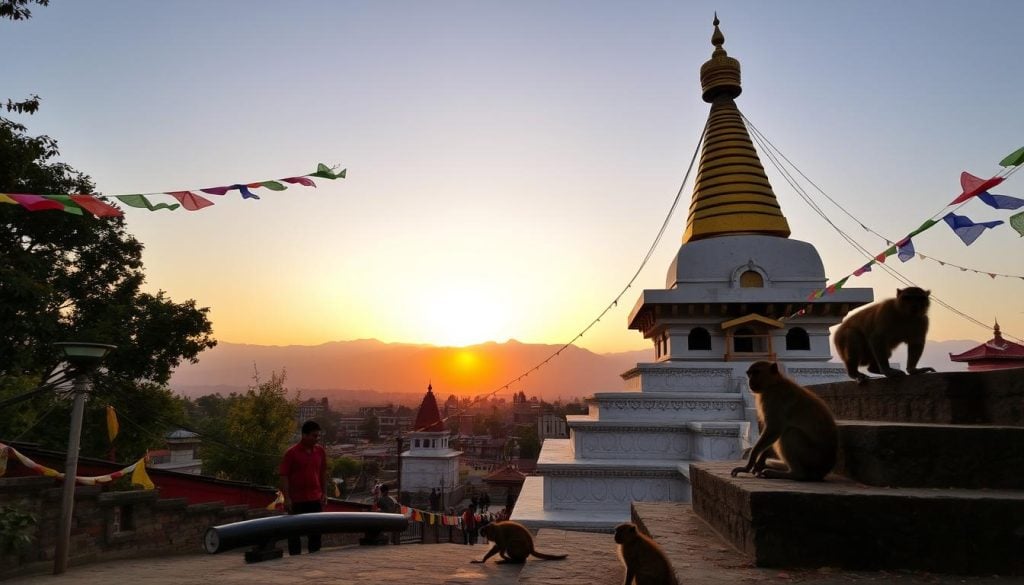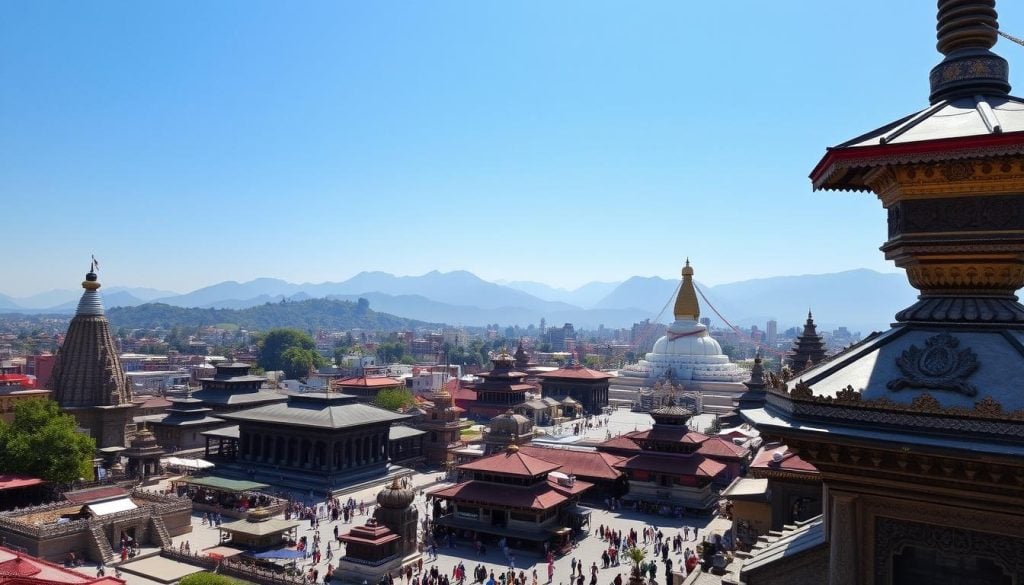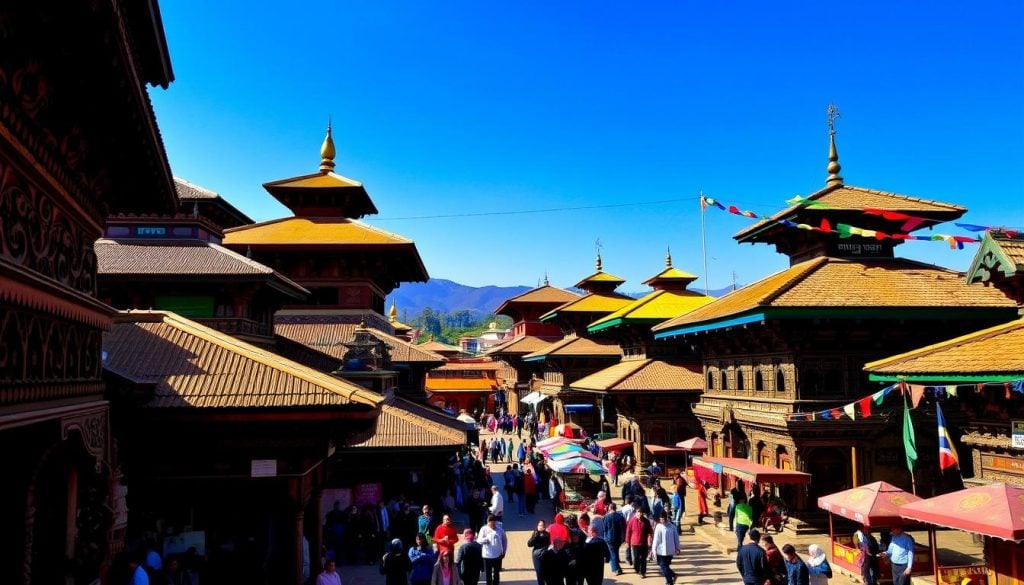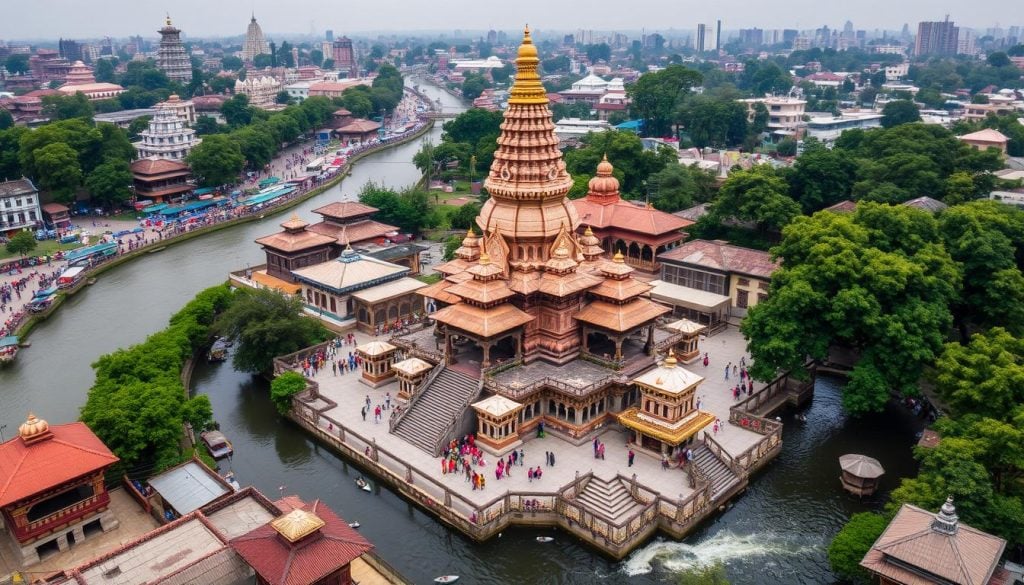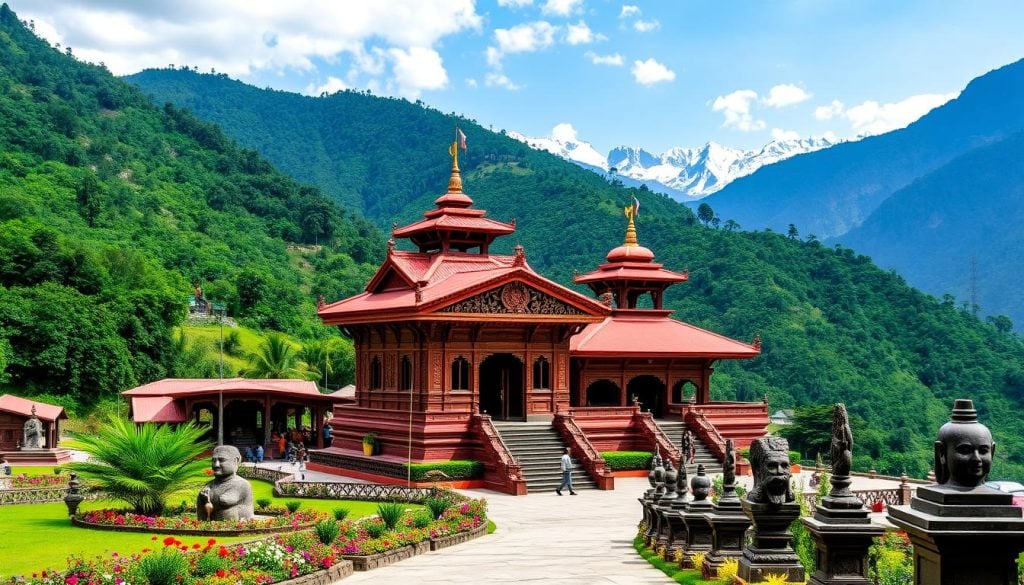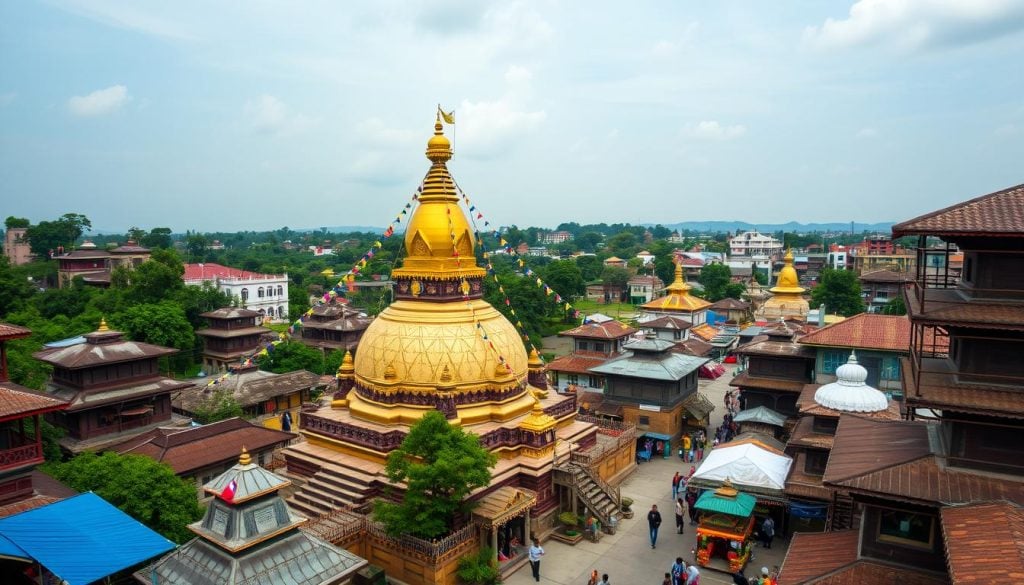Have you ever wondered how one city can hold centuries of history and diverse cultures in a few square miles? Kathmandu, the heart of Nepal, is a treasure trove of cultural sites. These sites are filled with rich stories and stunning beauty. From ancient temples to intricate palaces, they show the artistic skill of the Newar people and tell of a vibrant past.
As you explore this enchanting valley, you’ll find must-see cultural landmarks in Kathmandu. These include seven UNESCO World Heritage Sites that highlight the city’s historical importance. Let’s discover the wonders of Kathmandu’s cultural heritage together. We’ll uncover the rich tapestry that makes this city a true historical marvel.
Introduction to Kathmandu’s Cultural Heritage
Kathmandu is a doorway to the rich history of Nepal historical landmarks. This lively city has been shaped by many dynasties, like the Gopal, Kirat, Lichhavi, Malla, and Shah. Each one added something special to the city’s culture and buildings.
When you start exploring exploring Kathmandu’s cultural heritage sites, you’ll see many different traditions. The city is known for its mix of religions, customs, and art. These sites are not just old buildings; they show how Nepal’s traditions are still alive today. The city’s festivals and food are full of color and joy.
Dive into Kathmandu’s history and culture. Discover why these Nepal historical landmarks are so important. Every visit helps you understand the mix of heritage and community life in the valley.
| Cultural Influence | Dynasty | Key Contributions |
|---|---|---|
| Architecture | Malla | Development of intricate temple designs |
| Art | Lichhavi | Vibrant murals and stone sculptures |
| Religious Practices | Shah | Introduction of contemporary Hindu customs |
The Importance of Kathmandu Cultural Sites
The cultural sites in Kathmandu are very important for both locals and visitors. These sites help us understand the rich heritage of the region. Places like Pashupatinath Temple and Kathmandu Durbar Square show the spiritual and artistic side of the city.
Each site tells a story of Nepal’s history and traditions. You can see lively rituals and community events around these places. Keeping these sites preserved means future generations can enjoy this cultural treasure. Visiting these sites helps us appreciate the unique customs of this vibrant city.
Visiting these cultural spots gives us a peek into traditional practices and values. Walking through these sites, we connect with the stories of those who came before us. These sites are more than just tourist spots; they are a big part of local life, telling the story of Kathmandu.
| Cultural Site | Significance | Location |
|---|---|---|
| Kathmandu Durbar Square | Historic royal palace and cultural hub | Kathmandu |
| Pashupatinath Temple | Sacred Hindu temple and cremation site | Near the Bagmati River |
| Swayambhunath (Monkey Temple) | Important Buddhist pilgrimage site | Western Kathmandu |
| Boudhanath Stupa | One of the largest stupas in Nepal | Boudha |
Must-Visit Cultural Sites in Kathmandu Valley
The Kathmandu Valley is full of cultural wonders waiting for you. To really discover Kathmandu’s rich cultural heritage, you need to see its amazing cultural sites. These sites show the valley’s rich history and diverse traditions. Here are some top cultural sites in Kathmandu, each with its own story.
- Kathmandu Durbar Square
- Bhaktapur Durbar Square
- Patan Durbar Square
- Swayambhunath Stupa
- Boudhanath Stupa
- Pashupatinath Temple
- Changunarayan Temple
These sites highlight Nepali culture’s art, architecture, and spiritual importance. For instance, Kathmandu Durbar Square is famous for its grand palaces and temples. Bhaktapur gives a peek into traditional Newari life.
Visiting these landmarks is key to understanding Kathmandu’s cultural heart. As you explore, you’ll see the city’s traditions and art. This makes your trip unforgettable. You’ll also get to experience local customs and community life.
| Site Name | Key Features | Cultural Significance |
|---|---|---|
| Kathmandu Durbar Square | Royal palaces, intricate temples | Historical center of the Malla kings |
| Bhaktapur Durbar Square | Traditional architecture, pottery | Preservation of Newari culture |
| Patan Durbar Square | Bronze sculptures, museums | Artistic hub of the valley |
| Swayambhunath Stupa | Sacred site, panoramic views | Symbol of Buddhist faith |
| Boudhanath Stupa | Massive mandala, vibrant atmosphere | Center of Tibetan Buddhism in Nepal |
| Pashupatinath Temple | Hindu cremation ghats, sacred river | Most important Hindu temple in Nepal |
| Changunarayan Temple | Oldest temple, intricate carvings | World Heritage site showcasing ancient architecture |
Visiting these cultural sites in Kathmandu will give you a deeper love for the city’s culture. It will also help you appreciate the legacy of past generations.
Kathmandu Durbar Square: A Historical Marvel
Kathmandu Durbar Square is a top cultural site in Kathmandu. It has ancient temples, palaces, and detailed work that tells old stories. The square was the royal palace for the Malla kings and later the Shah dynasty until 1896. Here, you can see the historical importance of Hanuman Dhoka and other major sights.
Key Attractions Within Durbar Square
The square has many highlights that attract visitors worldwide. Some of these are:
- Hanuman Dhoka Palace: A former royal palace that is a key landmark in the square.
- Taleju Mandir: A sacred temple dedicated to the goddess Taleju, known for its striking architecture.
- Nine-Story Basantapur Tower: This tower offers a stunning view of the square and its surroundings.
Historical Significance of Hanuman Dhoka
Hanuman Dhoka’s historical importance is huge. It was a key place for royal coronations and other big events. This area shows the heart of Nepal’s cultural heritage, making it a must-see for anyone exploring Kathmandu’s cultural sites. Visiting this iconic spot connects you to Nepal’s rich history and traditions.
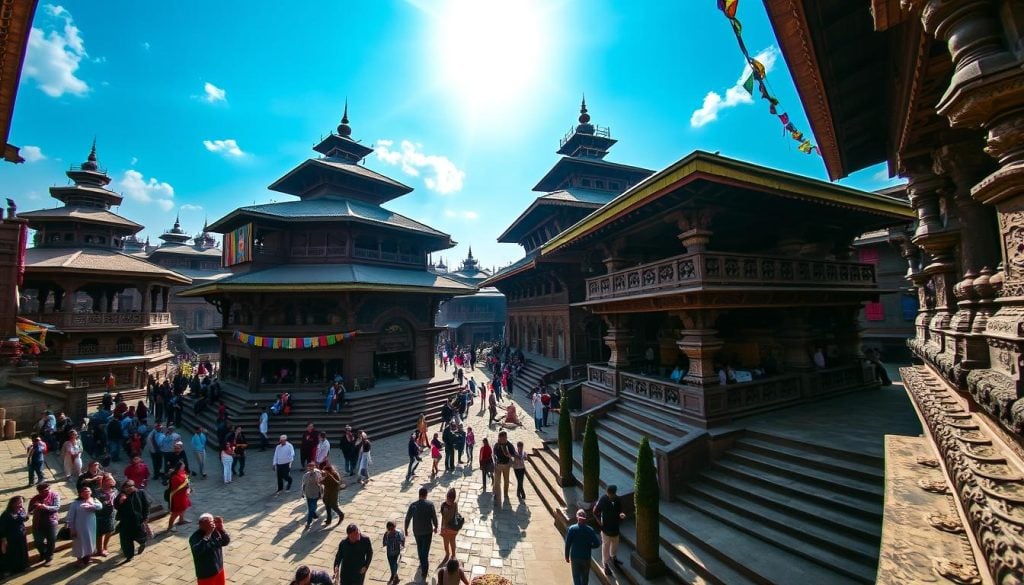
| Attraction | Description | Significance |
|---|---|---|
| Hanuman Dhoka Palace | Former royal residence with intricate architecture | Symbol of Malla kings’ power |
| Taleju Mandir | Temple dedicated to the goddess Taleju | Showcases religious beliefs of the era |
| Nine-Story Basantapur Tower | Tower offering views of the Durbar Square | Importance as a vantage point for royal ceremonies |
Exploring Bhaktapur Durbar Square
Bhaktapur Durbar Square is a top cultural spot in Kathmandu. It showcases traditional Newari architecture with detailed wooden carvings and colorful temples. These structures tell stories of the past.
One must-see is the Palace of Fifty-Five Windows. It highlights the medieval craftsmanship and artistry.
Craftsmanship and Architecture
The architecture in Bhaktapur shows the area’s rich cultural heritage. Each building showcases the Newari artisans’ skills. The Naytapola Temple and Vatsala Temple are great examples of intricate woodwork and designs.
Visiting these sites lets you see how spirituality and art blend. It’s a key highlight among cultural attractions in Kathmandu.
Don’t Miss Out on Local Delicacies
Trying Bhaktapur’s famous foods is essential. Make sure to taste Juju Dhau, known as king curd. It’s a local favorite that adds to the square’s historical charm.
Enjoying local dishes makes your visit unforgettable. It’s a key part of exploring one of the best cultural sites in Kathmandu.
Patan Durbar Square: A Cultural Hub
Patan Durbar Square is a key cultural spot in Kathmandu, showing off the Newar culture’s artistic side. It’s filled with temples, carvings, and architecture that will amaze you. Each building’s details are so intricate, it’s a must-see in Kathmandu.
The Mahabouddha Temple stands out with its terracotta tiles and Buddha images. The Golden Temple is known for its gold exterior. These temples highlight the area’s cultural and architectural achievements.
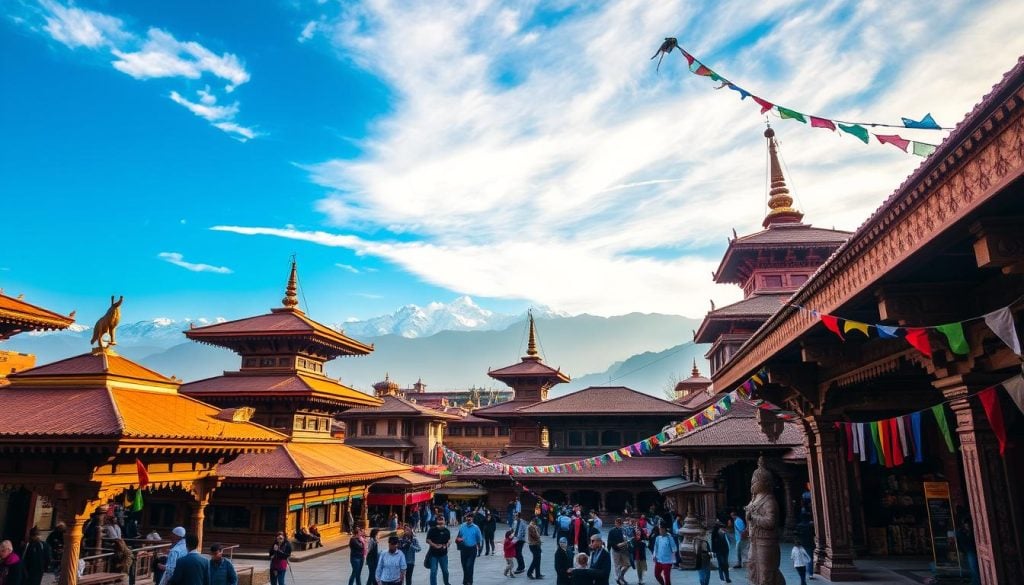
Exploring the square, you’ll find a lively scene with local artisans and shops. It’s a place where history meets modern life. Visiting Patan Durbar Square is a must for anyone wanting to dive into Kathmandu’s culture.
| Attraction | Features | Significance |
|---|---|---|
| Mahabouddha Temple | Terracotta tiles, intricate carvings | Symbol of Buddhist devotion |
| Golden Temple | Gold-plated exterior, rich sculptures | Center of spiritual and architectural significance |
| Patan Museum | Exhibits on art and culture | Highlights Newar artistic craftsmanship |
Spiritual Sites: Swayambhunath and Boudhanath
In Kathmandu, you’ll find ancient sites like Swayambhunath and Boudhanath. They are symbols of devotion and architectural beauty. These places are key religious centers, offering a peek into Nepalese culture and traditions.
Features of the Swayambhunath Stupa
Swayambhunath, or the Monkey Temple, is a sacred Buddhist site from the 5th century. It’s famous for:
- All-Seeing Eyes: The stupa has the Buddha’s eyes, symbolizing wisdom and compassion.
- Panoramic Views: On a hilltop, it offers breathtaking views of the Kathmandu Valley, enhancing your spiritual journey.
- Rich Symbolism: The statues and paintings around the stupa show amazing craftsmanship and tell important Buddhist stories.
Insights into Boudhanath’s Cultural Significance
Boudhanath is the world’s largest stupa and a key spot for Tibetan Buddhism in Nepal. It’s known for:
- Cultural Melting Pot: With many monasteries nearby, the site is alive with monks and pilgrims, creating a spiritual vibe.
- Architectural Marvel: The stupa’s design represents the universe, blending complex shapes with religious symbols.
- Cultural Festivals: Boudhanath hosts colorful festivals all year, attracting locals and tourists to see traditional rituals.
Exploring these kathmandu cultural sites deepens your understanding of Nepal’s heritage. It also connects you to its spiritual roots. Make sure to visit these sacred places to truly grasp their historical and cultural importance.
Pashupatinath Temple: A Sacred Spot for Hindus
Pashupatinath Temple is a key must-visit cultural site in Kathmandu. It sits by the Bagmati River and is a major shrine for Lord Shiva. People from all over come to see its stunning two-tiered pagoda and feel its spiritual vibe.
The temple area has many smaller temples and shrines. They add to the rich religious life here. You can see traditional rituals and even open cremations by the river, showing the local customs of life and death.
Visiting Kathmandu cultural sites isn’t complete without Pashupatinath. It’s a place of peace and spiritual activity. Here, you can connect deeply with Nepal’s religious traditions.
| Feature | Description |
|---|---|
| Location | Bagmati River, Kathmandu |
| Dedicated To | Lord Shiva (Pashupati) |
| Architecture | Two-tiered pagoda style |
| Significance | Major pilgrimage site for Hindus |
| Cremation Ghats | Located along the river for ritual practices |
Changunarayan Temple: The Oldest Temple in Kathmandu Valley
Changunarayan Temple is a symbol of Nepal’s rich history and art. Built in the 4th century, it is a temple dedicated to Lord Vishnu. It is the oldest temple in the valley still in use today. This site is a great chance to discover Kathmandu’s rich cultural heritage.
The temple’s design is a pagoda-style, with beautiful wood and stone carvings. These carvings show the skill of ancient Nepalese artists. Walking through this temple, you’ll see its beauty and feel a calm atmosphere.
Changunarayan Temple is near Bhaktapur and is a top cultural attraction in Kathmandu. Here, you can see the local community’s traditions. You can watch rituals and practices that have stayed the same for centuries.
Changunarayan Temple is more than just beautiful; it’s a place for deep thought and spiritual growth. It connects you to Nepal’s history and culture. It invites you to dive into its spiritual and cultural traditions.
| Attribute | Description |
|---|---|
| Year Established | 4th Century |
| Deity | Lord Vishnu |
| Architectural Style | Pagoda |
| Location | Near Bhaktapur |
| Significance | Oldest functioning temple |
| Cultural Importance | Displays ancient craftsmanship |
Kathmandu Cultural Sites: A UNESCO World Heritage Perspective
Kathmandu Valley is a treasure trove of cultural heritage, boasting seven UNESCO World Heritage Sites. Each site tells a story of history and art, making it a key spot for cultural tourism in Nepal. Places like Kathmandu Durbar Square, Swayambhunath, and Pashupatinath give visitors a peek into the valley’s blend of religion and culture.
These sites are not just religiously significant but also showcase incredible craftsmanship. The architecture of each monument tells tales of a lively past, drawing in both visitors and locals. Every step you take uncovers more history, revealing the depth of the valley’s stories.
Exploring these UNESCO sites helps us understand Nepal’s rich heritage. By preserving these sites, we ensure they remain a treasure for future generations. Take the chance to see these wonders and experience the centuries of art and spirituality they hold.
Conclusion
Your journey through Kathmandu’s cultural sites shows a deep story from centuries past. Each spot, from lively squares to peaceful temples, gives a peek into Nepal’s rich culture. By exploring these landmarks, you learn more about Nepal’s faith and its lasting heritage.
Visiting Kathmandu’s cultural sites leaves you with memories that touch the heart of this lively nation. Every visit makes you appreciate the skill and beauty in the valley’s buildings. It connects you to the old traditions and stories that define the area.
In the end, Kathmandu’s cultural sites show the strength and creativity of its people. They bring people together and create a sense of community. By diving into these stories, you help keep Nepal’s culture alive for future generations.

































